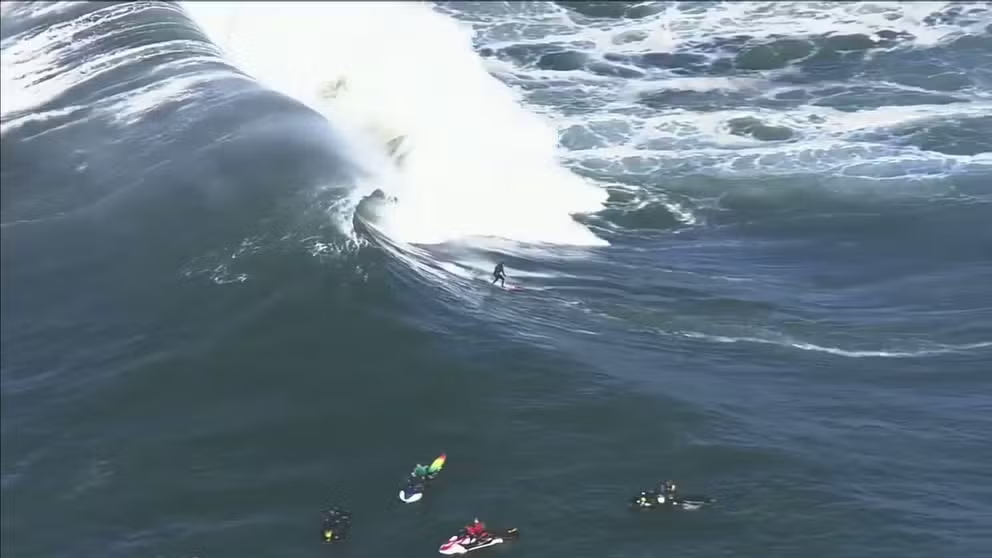How weather impacts waves during surfing competitions
To forecast waves, you must be able to forecast weather. Here is a look at what weather drives the biggest waves on Earth.
Surfing massive waves
This is file video of clips of the 2004 winners of the Billabong XXL Global Big Wave Awards.
Surfing competitions depend heavily on the ocean, but the weather will ultimately determine when organizers can let surfers begin.
All eyes in the surfing world are watching waves off Peniche, Portugal. The World Surf League’s Championship Tour MEO Rip Curl Pro Portugal window is open from March 8 to 16. You may wonder why this sporting event has a window instead of set days.
Kevin Wallis, the Director of Forecasting for Surfline, consults with the World Surf League and is tasked with analyzing storms and weather conditions and recommending days with the best surf.

PENICHE, Portugal - The 2022 MEO Pro Portugal tournament.
(Damien Poullenot/World Surf League / Getty Images)
"My job as a forecaster is to help them get the best waves within any event window period. So, for example, they had their first event of the year at Pipeline (Hawaii) late January to early February, and they had a 12-day window to run out of that," Wallis said. "And we helped them take the best three days in that window to complete the event for both men and women."
Some windows span months, like the one for Pe'ahi in Maui, Hawaii. Wallis has to identify one day of the "biggest and the best days" from November through March.
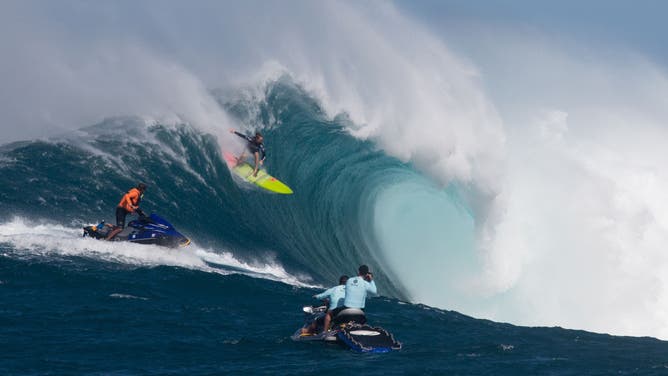
Hawaiian surfer Paige Alms surfs a big wave at Jaws, off the coast of the Maui Island in Hawaii to win the Pe'ahi Challenge 2016, on November 11, 2016, the first-ever Women's Big Wave Tour event. Also known as "Jaws," Pe'ahi is on the northern coastline of Maui and can produce waves that are upwards of 60 feet.
(BRIAN BIELMANN/AFP / Getty Images)
"Pe’ahi is arguably the most perfect and high-performance big wave in the world," states Surfline. "There are slabbier waves. There may be taller waves. There are waves with more history and waves that break further out in the middle of the ocean. But by most accounts, Jaws is the most surfable giant wave on Earth."
One surfer told Surfline that it is no wonder they call it ‘Jaws’ because when you see it, your jaw drops.
When is the tournament on?
"How that works is, for an event to get the yellow light, meaning they were really watching the swell closely around 5 to 6 days before it happens," he explained. "And then typically the event is called ‘on’ somewhere between 48 and 72 hours before the event happens. So that allows the athletes to travel."
Wallis said he is eyeing a Friday start for the Portugal tournament, "It will very likely run over the weekend with pumping surf and good wind/conditions."
CALIFORNIA SURFERS RIDE WAVES DURING BOMB CYCLONE
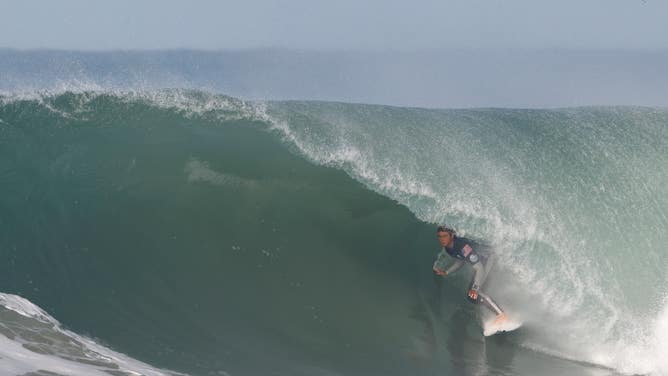
A surfer in a barrel or tube at the 2022 MEO Pro Portugal tournament.
(Joao Rico/DeFodi Images / Getty Images)
What is the recipe for monster waves?
Wallis said the ingredients for big waves are simple, winds over the ocean. The stronger the wind, the longer it blows, and the more area it touches, the bigger the waves. In most cases the strongest storms happen during winter in each hemisphere. He uses Mavericks in central California as an example, but the science works for most surf breaks in the Northern Hemisphere.
Surfline writes, "Mavericks is one of the top 3 waves in the world for raw power.
PRO BIG WAVE SURFER TALKS ABOUT THE SCIENCE BEHIND RIDING MONSTER WAVES
Surfing Mavericks
File: Aerial footage of surfers catching waves at Mavericks.
"So typically, what you want to see is a storm, usually around at least a thousand miles to the northwest of Mavericks. And the sweet spot seems to be somewhere between 2,000 and 1,000 miles away," Wallis said. "So you've got a big storm that is capable of producing a large swell that is far enough offshore that you don't get all the weather associated with that storm."
Add in a little persistent high pressure over the western U.S. which provides light winds and sunny skies, and surfing can be perfect with the break about a half to a mile off the beach. Even better, he said, add in an offshore wind (blowing from the land against the waves).
"Because what they often will do is hold up the lip of the breaking wave so that you can get what we call barrels," Wallis said. "Offshore wind tends to be good, and they're not going to be creating chop within the surf zone."
He compared chop in the surf zone or "bumpy waves" to moguls on a ski slope. Onshore winds create the chop.
What happens when a wave breaks? How big can waves grow?
Wind over water creates swells that move. Swells out in the ocean are just bumps to boats, but when the seabed slows down the bottom of the circular motion, the top of the wave races ahead and topples over or breaks.
"You can kind of think of them (swells) like icebergs, especially out in the middle of the open ocean where it's very deep," said Wallis. "There might be a swell of a wave of 10 to 15 feet that. If it's got a very long period, energy extends really far below the surface of the ocean. In the case of very long periods, as much as a thousand feet below the surface of the ocean."
A swell period is a time between wave peaks. Once a wave hits a depth of one-and-a-half of its height, it breaks, Wallis explains. So, a 5-foot wave, from bottom to crest, would generally break in around 7 feet of water.
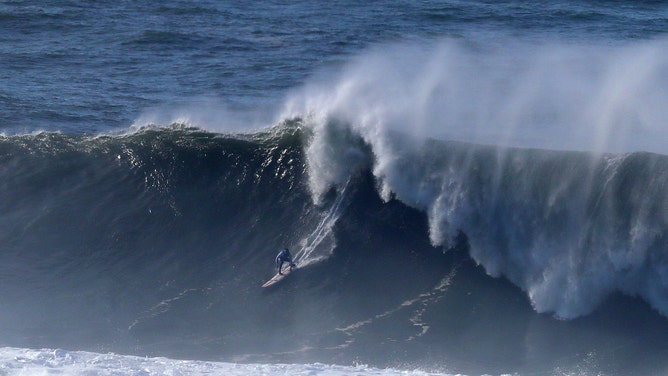
File: A surfer rides a wave at Mavericks in December 2018. The longer the period, the bigger the swell and wave.
(Aric Crabb/Digital First Media/Bay Area News / Getty Images)
And the water has nowhere to go but up when it hits bottom, so waves grow. The longer the period, the deeper the energy/circulation goes.
"So you can have what is certainly not a small but not a really big swell, out in the open ocean," said Wallis. Let's say it's a 15-foot swell with a swell period of 20 seconds out in the open ocean that can grow to 50 to 60 to even 70 feet (when it breaks)."
Not every surf beach is created equal. What's under the water counts too
Bathymetry, shape and depth of the seafloor also have much to do with crafting the perfect wave. The seafloor beyond Nazare, Portugal, is the "equivalent to the Grand Canyon," said Wallis. Nazare is just north of Peniche, and where Sebastian Steudtner surfed a Guinness World Record wave of 86 feet.
HOW TO WATCH FOX WEATHER ON TV
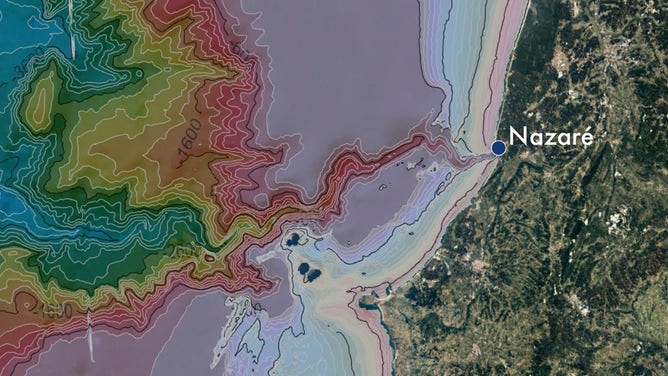
The deep Nazare Canyon is depicted in red and is adjacent to the beach.
(Surfline / FOX Weather)
"It regularly produces the largest ridable waves on planet Earth," states Surfline, thanks to the Nazare Canyon.
"It extends for 100 miles, and it's up to three miles deep in certain places. But the way that that longer period, northwest swell interacts with that canyon can bend and refract waves into that surf zone," Wallis said. "And then adjacent to those really big waves, where the waves are focusing, and you're left in somewhat of a swell void."
OCEAN RESEARCHERS TURN CALIFORNIA STATE BEACH PINK TO LEARN ABOUT COASTAL DYNAMICS
He said that the waves in Nazare could be 80 to 100 feet tall. Then just around the corner, half-a-mile away, the waves are a quarter of the size or smaller.
All the weather patterns are opposite in the Southern Hemisphere. For example, low pressure circulates clockwise, and winter runs from June to August.
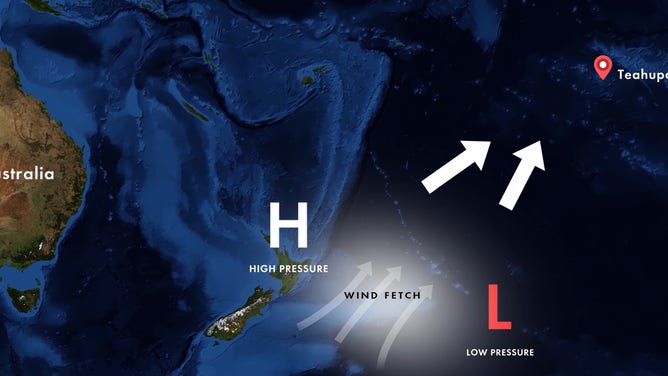
The recipe for mega waves in Tahiti.
(Surfline / FOX Weather)
Wallis’ attention will be on Teahupo’o, Tahiti, between August 11 and 20.
"The World Surf League has an event there this August. They go every year. Actually, one of the most popular events from a broadcast perspective and fan perspective, because it's probably one of the most, if it's not the most, spectacular wave on tour. It's right up there at the top."
Teahupo'o will also be the sight of the surf competition for the 2024 Paris Olympics. Wallis will again be tasked with the timing.

